
Cracking the Chiropractic Controversy
(written by Carla Swerman, Archives staff)
“Some people swear by them, while others swear at them” is a common saying that can be applied to many things in life, including chiropractors. Regardless of anyone’s view of chiropractics, La Crosse made history in 1907 when a local Japanese-American chiropractor, Shegetaro Morikubo, proved that chiropractics and osteopathy are not the same profession. His landmark court case, originating in La Crosse, Wisconsin, led to the recognition of chiropractics as a distinct medical practice.

Born into an aristocratic family in Tokyo, Dr. Shegetaro Morikubo practiced osteopathy and chiropractics in the Midwest. He was pictured amongst other distinguished La Crosse residents in the 1908 book Portfolio of La Crosse People: Past and Present.
Back in 1907, Americans were concerned about a potential war with Japan. Of little concern was chiropractics, a practice that was in its infancy. Only twelve years earlier, Daniel David (D.D.) Palmer had performed the first chiropractic adjustment in Davenport, Iowa. After attending the Palmer School of Chiropractic in 1906, Shegetaro Morikubo moved to La Crosse and became the first registered chiropractor in the state of Wisconsin. While his Japanese heritage created some unease due to the strained relationship between Japan and the United States, it was Morikubo’s strong belief in chiropractics that led to a two-day trial that riveted La Crosse residents and impacted the entire nation.
However, the controversy over chiropractics in La Crosse did not start in 1907. Two years earlier, two non-licensed chiropractors, G.W. Johnson and E.J. Whipple, “set up shop” at 318 Main St. and immediately attracted patrons. But, within walking distance, was a “competing” osteopath of influence. A.U. Jorris, whose practice was inside the McMillan Building at 401 Main St., was a member of the Wisconsin Board of Medical Examiners (BME).
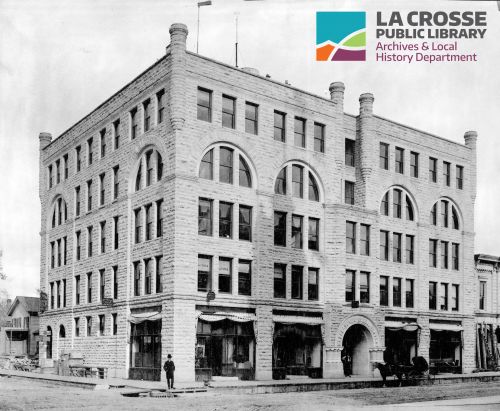
This 1887 photo depicts the McMillan Building, now State Bank Financial, at 401 Main Street. Osteopath A.U. Jorris practiced here as did the “competing” chiropractor Shegetero Morikubo in 1907.
Like all osteopaths, Jorris was contemptuous of chiropractics, a “fake version” of osteopathy, which focuses on blood, the musculoskeletal system, and overall health. Chiropractors, on the other hand, focus on nerves, biomechanics, and the spine. Still, the two kinds of practitioners were not viewed as distinct in the early 1900s. In fact, the Wisconsin State Medical Board contended that both kinds of practitioners were to be licensed under osteopathy. Only osteopaths, medical doctors, and surgeons required licensure.
With that in mind, Jorris contacted local authorities and the Wisconsin BME about Johnson and Whipple’s lack of licensure. In court, D.D. Palmer’s testimony about the differences between the two medical practices was not enough to keep Johnson and Whipple in business.
In that same month of October 1905, D.D. Palmer experienced a second defeat. He himself was charged with practicing chiropractics without licensure. Rather than pay the $350 fine, he went to jail. Soon after, he turned the Palmer School of Chiropractic over to his son, Bartlett Johnson (B.J.) Palmer.
About this time, Morikubo entered the world of chiropractics. Born in 1877 to a prominent Tokyo family, Morikubo attended the Tokyo Academy of Science. He came to the United States at the age of 19 and studied theology and metaphysics at the University of California–Berkeley. While there, he converted to Christianity; as a result, his family disowned him.
At age 24, Morikubo earned his doctorate of philosophy and moved to Minnesota, perhaps due to his love of fishing. For the next five years, he lived in various Minnesota communities where he lectured on religion, Japanese culture, and medicine. He also practiced the healing arts of electropathy and osteopathy, for which he had taken a correspondence course and was licensed to practice in Minnesota.
Whether Morikubo wanted to continue legally practicing drugless healing or he was truly interested in chiropractics, he headed to Davenport, Iowa, in March of 1906 to study at the Palmer School of Chiropractic. At first, he was not enamored with the schooling, but, while there, an epiphany occurred that put him “on fire” for chiropractics. As a student, he lectured on the philosophy of chiropractics, reviewed a book on chiropractics, and addressed his graduating class in December of 1906.

This photo from The Institute Chiropractic shows D.D. Palmer performing a chiropractic adjustment on Morikubo.
Still, there were no licensure requirements for chiropractors, who were subject to arrest for practicing medicine and/or osteopathy without a license. So, B.J. Palmer, Morikubo, and others conspired to create a two-part plan that would aid the profession. First, they established the Universal Chiropractors’ Association that still exists today as the American Chiropractic Association. With chiropractors paying dues to the organization, funds could be used to offset legal expenses. They also schemed a legal confrontation; Morikubo was the knowledgeable, well-spoken, and "nothing-to-lose" henchman.
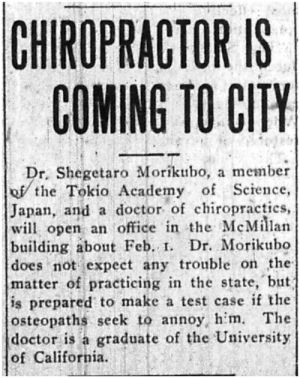
This front-page La Crosse Tribune article from Jan. 28, 1907, announces the arrival of Shegetaro Morikubo and indicates that Morikubo will defend chiropractics, if necessary.
Upon arriving in La Crosse, Morikubo hired a law firm with the expectation that there would be legal troubles. He himself ignited trouble by renting a space in the McMillan Building where A.U. Jorris was still practicing osteopathy. Morikubo then went about “drumming up business.” He lectured at churches and advertised in both German and English, of which he was equally fluent. In March, he had 25 patients; a month later, he had 70. In the meantime, A.U. Jorris had convinced the chairman of the Wisconsin BME, Dr. W.T. Searles, to take action.
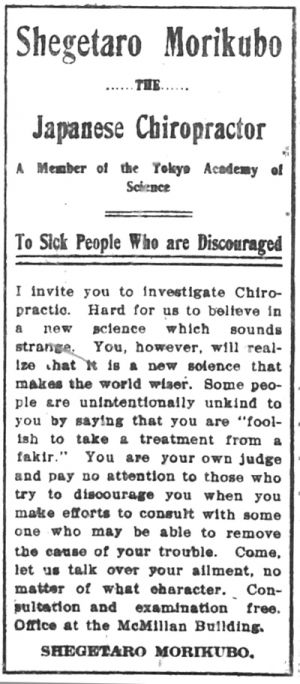
In this May 1, 1907, advertisement that appeared in the La Crosse Tribune, Morikubo offered a free consultation to anyone who was willing to try chiropractics, despite nay-sayers.
Morikubo was arrested on July 22, 1907, for practicing osteopathy under the guise of chiropractics. The La Crosse Tribune’s account included this comment from Morikubo: “‘I am an American citizen, duly naturalized and insist upon my American rights and liberties,’ said the man with flashing eyes to a Tribune reporter. ‘I will not report the case to my government. In turn, I will carry it to the supreme court for a decision, and, if worsted, will quit the state. I am confident that the state cannot prove the case, while I can show that osteopathy and chiropractics are two entirely different sciences.’”
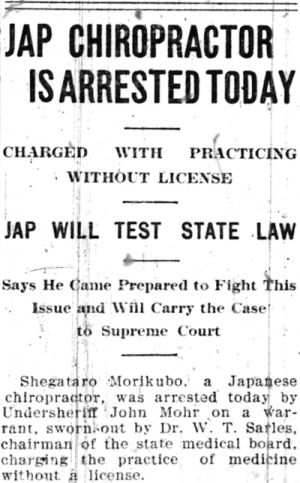
The announcement of Morikubo’s arrest made the front page of the July 22, 1907, La Crosse Tribune. Please note that the La Crosse Public Library does not support the anti-Japanese sentiment and language used in the primary sources printed in this blog. Rather, to not discuss these articles would be considered to whitewash history.
During the two-day trial on August 13-14, 1907, legal and medical experts from all over the country testified as well as local patients. Jurors learned the differences between osteopathy and chiropractics. After just 25 minutes of deliberation, the jury of four found Morikubo innocent. Searles then contended that he would re-arrest Morikubo, but the defendant’s lawyer, Senator Tom Morris contended that such action would be “Japanese persecution.” An editiorial in the La Crosse Argus on Aug. 17, 1907, concurred by stating “Any further prosecution will simply be persecution.”
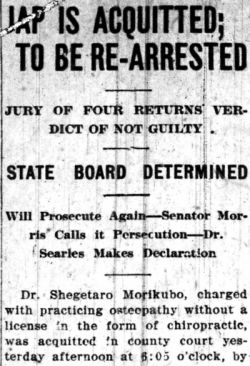
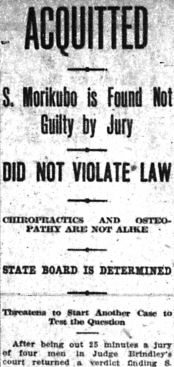
These articles appeared in the La Crosse Tribune and La Crosse Leader-Press on August 15, 2907, the day after Morikubo’s acquittal.
With that, chiropractors throughout the nation could now practice legally without licensure. Even with this victory, however, chiropractors were often harassed and either served jail time or paid a fine. That generated a lot of business for Morris and his colleagues, who traveled all over the county to defend chiropractors. By 1915, Wisconsin granted legal sanctions to chiropractors; they could practice freely as long as they advertised that they were not registered or licensed. But, ten years later, that all changed when Wisconsin chiropractors were required to meet educational requirements for licensure.

After defending Morikubo, Senator Thomas Morris’ law firm of Morris, Winter, Esch, Holmes, and Bosshard provided legal assistance to chiropractors nationwide. Even at the time of his death in 1928, Morris was defending a New York chiropractor. Photo courtesy of UW-L Murphy Library, Special Collections.
As for Morikubo, he continued to successfully practice chiropractics in La Crosse and married Louise Harrison of La Crosse on July 30, 1908. Their only child, Bruce, was born July 19, 1909. In 1910, the family moved to Minneapolis where Morikubo was an active chiropractor until his death in 1933.
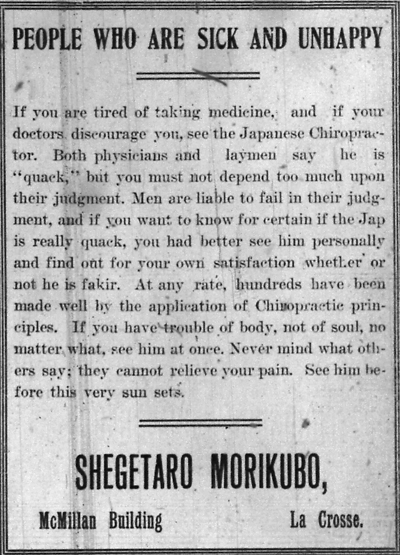
After the trial, Morikubo continued to advertise in La Crosse newspapers. In this one from March of 1908, he asserts that “. . . if you want to know for certain if the Jap (sic) is really a quack, you had better see him personally.”
An erudite man of many accomplishments, Morikubo is most remembered for “cracking the chiropractic controversy” in just two days and “aligning” chiropractics as a recognized medical practice.

